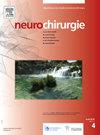Microsurgical clipping of ruptured basilar artery perforator aneurysms in the endovascular era: A single-center experience
IF 1.4
4区 医学
Q4 CLINICAL NEUROLOGY
引用次数: 0
Abstract
Background
Basilar artery perforator aneurysms (BAPAs) are a rare subset of intracranial aneurysms, accounting for <1% of cases. The natural history of BAPAs is unknown, and a standardized management approach is lacking. This report presents the largest cohort of surgically treated BAPAs to date, addressing gaps in the literature and guiding management strategies.
Methods
A single-center retrospective analysis was conducted utilizing a prospectively maintained, IRB-approved database, which included a series of seven consecutive patients treated for BAPAs. The dataset included patient characteristics, surgical details, postoperative outcomes, complication rates, and imaging and clinical follow-up data. It also featured case illustrations.
Results
A total of seven patients were included, all presenting with subarachnoid hemorrhage. The median age was 60 years (IQR: 56.5, 69), and 57% were female. The most common location of the perforators was mid-basilar (43%). Five cases (71.4%) had aneurysms that went undetected on the initial angiogram. All patients underwent microsurgical clipping as their treatment. Post-surgery, oculomotor nerve palsy was observed in four patients (57.1%), and three (42.8%) experienced hemiparesis, which improved during their hospital stay. Follow-up diagnostic angiograms revealed a complete aneurysm occlusion of all aneurysms with no residual filling.
Conclusion
Microsurgical clipping is an effective treatment option for BAPAs when observation and endovascular interventions are not feasible. Treatment decisions should be guided by presentation, aneurysm characteristics, and overall risk profile. A multicenter registry is needed to establish standardized management guidelines. A multidisciplinary, tailored approach is recommended to optimize individual patient outcomes.
血管内时代破裂基底动脉穿支动脉瘤的显微外科夹持:单中心经验
背景:基底动脉穿支动脉瘤(BAPAs)是颅内动脉瘤中一种罕见的亚群,约占病例的1%。BAPAs的自然历史尚不清楚,缺乏标准化的管理方法。本报告介绍了迄今为止手术治疗bapa的最大队列,解决了文献中的空白并指导了管理策略。方法采用前瞻性维护的经irb批准的数据库进行单中心回顾性分析,该数据库包括一系列连续7例接受BAPAs治疗的患者。数据集包括患者特征、手术细节、术后结果、并发症发生率、影像学和临床随访数据。它也有案例插图。结果共纳入7例患者,均表现为蛛网膜下腔出血。中位年龄为60岁(IQR: 56.5, 69), 57%为女性。最常见的穿支位置是中基底动脉(43%)。5例(71.4%)的动脉瘤在最初的血管造影中未被发现。所有患者均行显微手术夹持治疗。术后4例(57.1%)患者出现动眼神经麻痹,3例(42.8%)患者出现偏瘫,住院期间病情有所改善。随访诊断血管造影显示所有动脉瘤完全闭塞,无残留填充。结论显微手术夹持术是治疗BAPAs的有效方法,在观察和血管内干预均不可行的情况下。治疗决定应以表现、动脉瘤特征和总体风险概况为指导。需要一个多中心注册中心来建立标准化的管理指南。建议采用多学科、量身定制的方法来优化个体患者的预后。
本文章由计算机程序翻译,如有差异,请以英文原文为准。
求助全文
约1分钟内获得全文
求助全文
来源期刊

Neurochirurgie
医学-临床神经学
CiteScore
2.70
自引率
6.20%
发文量
100
审稿时长
29 days
期刊介绍:
Neurochirurgie publishes articles on treatment, teaching and research, neurosurgery training and the professional aspects of our discipline, and also the history and progress of neurosurgery. It focuses on pathologies of the head, spine and central and peripheral nervous systems and their vascularization. All aspects of the specialty are dealt with: trauma, tumor, degenerative disease, infection, vascular pathology, and radiosurgery, and pediatrics. Transversal studies are also welcome: neuroanatomy, neurophysiology, neurology, neuropediatrics, psychiatry, neuropsychology, physical medicine and neurologic rehabilitation, neuro-anesthesia, neurologic intensive care, neuroradiology, functional exploration, neuropathology, neuro-ophthalmology, otoneurology, maxillofacial surgery, neuro-endocrinology and spine surgery. Technical and methodological aspects are also taken onboard: diagnostic and therapeutic techniques, methods for assessing results, epidemiology, surgical, interventional and radiological techniques, simulations and pathophysiological hypotheses, and educational tools. The editorial board may refuse submissions that fail to meet the journal''s aims and scope; such studies will not be peer-reviewed, and the editor in chief will promptly inform the corresponding author, so as not to delay submission to a more suitable journal.
With a view to attracting an international audience of both readers and writers, Neurochirurgie especially welcomes articles in English, and gives priority to original studies. Other kinds of article - reviews, case reports, technical notes and meta-analyses - are equally published.
Every year, a special edition is dedicated to the topic selected by the French Society of Neurosurgery for its annual report.
 求助内容:
求助内容: 应助结果提醒方式:
应助结果提醒方式:


